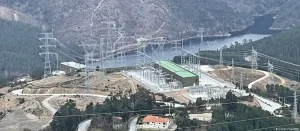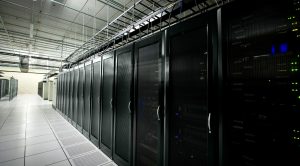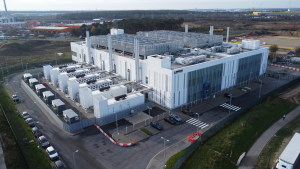EXCLUSIVE: The Great Build-Out. Part 2. Politics of Data Center Construction.

If you want to see the AI boom, don’t look at chatbots. Look at dirt.
All over the US, fields are being scraped flat for windowless, humming boxes – data centers – big enough to swallow shopping malls. In Wyoming, Wyoming Star’s previous reporting describe ranchland and wheat fields turning into “AI factory” sites almost overnight, as global cloud companies race to lock down cheap land, power, and fiber.
To some people, this looks like the next industrial revolution. To others, it looks like an energy, water, and land-use crisis dressed up as innovation.
What’s new is not just the scale of construction, but the politics of it. The Biden and Trump administrations have effectively turned data center build-out into a national strategic project. States like Wyoming are cheering. Counties, grid operators, and neighbors with rising power bills are… significantly less enthusiastic.
This is a story about that collision: the federal push and the local response.
The numbers behind the boom are eye-popping.

Engineers at STAX, a pollution-control company that sells emissions capture gear to data centers, note that all data centers worldwide already consume about 32% more electricity than the entire United Kingdom. They count roughly 7.2 million data centers worldwide and say US facilities – about 2,700 of them – already use over 4% of US electricity, a share projected to rise to 6% by 2026 and possibly 8% by 2030 as AI workloads take off.
That power doesn’t come for free. STAX points out that Cooling alone can account for 40% of a data center’s electricity use, often with huge water footprints –hundreds of thousands of gallons a day for a single large facility. Big campuses rely on forests of diesel backup generators; one Virginia project proposed 168 diesel gensets capable of 504 MW just to sit ready for outages.
That’s what lands on local communities: noise, diesel exhaust, grid upgrades, water stress.
From the national altitude, the pattern looks different. Business Insider’s map of US data centers shows thick clusters around Northern Virginia’s “Data Center Alley,” the big tech corridors of Ohio and Iowa, and a fast-growing arc through Texas, Arizona, and the Mountain West. Wyoming, Utah, and other high-plains states – long used to exporting coal, gas, and wind – are suddenly being courted as places to host the physical backbone of AI.
In our previous reporting we’ve shown hyperscale campuses needing hundreds of megawatts of power, speculative proposals sized in gigawatts, and a land-use shift that feels to locals a lot like the early days of the shale boom – except this time the commodity is compute.
The environmental story and the industrial story are now inseparable. The question is whether this build-out is being steered – or whether policy is sprinting to keep up.
What’s been going on in the outside world?
On paper, Europe has been trying to do AI differently.
The European Commission’s “European approach to artificial intelligence” promises excellence and trust – big public investments in “AI Factories and Gigafactories,” supercomputers, and data infrastructure, paired with the landmark AI Act, a risk-based rulebook for high-risk systems. Recent updates – the AI Continent Action Plan and the new Apply AI Strategy – explicitly call for large-scale AI computing infrastructure, backed by EU-level money and the new AI Office in Brussels.
But the Brussels vision runs into physics.
An EU “In Focus“ note on data centers calls them an “energy-hungry challenge,” warning that data centers already account for a growing share of European power demand and could hit double-digit percentages in some countries by 2030 without efficiency and waste-heat-recovery rules. The Commission is now pushing energy-performance standards, heat reuse, and better monitoring of data centers as part of its climate and digital agenda.

Industry mapping from the Dutch Data Center Association and the European Data Centre Association shows where this is playing out: heavy concentration in the FLAP markets (Frankfurt, London, Amsterdam, Paris), with rapid expansion in Madrid, Dublin, the Nordics, and Central/Eastern Europe. Analysts at DataCenterKnowledge estimate European data center investment could top €100 billion by 2030, driven largely by AI and cloud.
At the same time, communities and regulators are pushing back. AlgorithmWatch’s report on Europe’s “infrastructure or intrusion” problem documents how data centers are pitched as critical infrastructure but experienced locally as land, noise, and water intrusions – especially when they land in greenfield rural areas rather than existing industrial zones.
Portugal is already a case study. A Deutsche Welle investigation describes how a data center boom in Portugal, including proposed campuses near Sines and Lisbon, is running head-first into grid constraints and worries about whether a relatively small national system can absorb clusters of energy-intensive facilities while still decarbonizing.
Politically, Europe’s AI regulation agenda has wobbled. Politico Europe reports that after trumpeting the AI Act as a global gold standard, the EU is now “hitting pause” on some aspects amid fears of scaring off AI investment, prompting a Digital Omnibus proposal to simplify and tweak the regime. The same Commission page that celebrates the AI Act now includes a section on “simplification” and efforts to keep implementation “innovation-friendly,” a quiet acknowledgment that Europe doesn’t want to regulate itself out of the AI race.
Meanwhile, Europe is already looking past land-based data centers. A new Euronews piece warns that Europe risks falling behind in space-based data centers – orbital platforms meant to offload energy-intensive computing – compared with more aggressive plans elsewhere.
So Europe is trying to square a circle: build AI infrastructure big enough to matter geopolitically, while keeping it “trustworthy,” efficient, and palatable to voters who don’t necessarily want a hyperscale facility next to their village.

If Europe is wrestling with how much AI infrastructure is too much, China is much closer to “never enough.”
Analysts at Goldman Sachs estimate that Chinese AI providers alone are on track to invest roughly $70 billion in data centers as part of an overseas expansion and domestic capacity splurge. A RAND “Full Stack” report describes how China’s AI industrial policy stretches from chip fabs to cloud platforms: state direction, subsidies, and regulatory support all stacked to build national capabilities.
Think tanks like MERICS describe Beijing’s “AI+” drive – embedding AI across manufacturing, logistics, agriculture, and public services – as a deliberate attempt to integrate AI into every sector, not just chatbots. The Economist now talks about China running a “different AI race,” less focused on consumer-facing tools and more on system-level integration and state power.
That strategy requires physical infrastructure. A Deutsche Welle analysis on Chinese AI and the DeepSeek model notes that despite US export controls on advanced chips, China is pouring resources into homegrown semiconductors, data centers, and graphics hardware to sustain its own AI stack.
The environmental and energy story is complicated.
Carbon Brief shows China moving many data centers to cooler northern and western regions and closer to renewable generation, while introducing efficiency standards and targets for Power Usage Effectiveness to manage surging electricity demand.
A MIT Technology Review investigation warns that some AI-oriented data centers have been overbuilt in remote regions, leaving capacity underused because of grid bottlenecks and misaligned incentives.

At the same time, China is experimenting with radically different form factors. Scientific American chronicles how Chinese companies are submerging data centers off the coast of Hainan and Shanghai, using seawater cooling and offshore wind power to cut electricity use by around 30% compared to land-based sites. Forbes contrasts this with US discussions about putting data centers in space, arguing that China’s underwater deployments could give it a head start in “extreme” infrastructure while the US toys with orbital concepts.
That experimentation is happening in a political context where support for AI seems higher. A survey reported by Al Jazeera finds trust in AI significantly higher in China than in Western democracies, where skepticism is fueled by concerns over job losses, bias, and misinformation. That social and political environment makes it easier for Beijing to push megaprojects with fewer local veto points.
In short: Europe is trying to build a regulated AI infrastructure; China is building a maximal one. The US is now trying to decide which way it wants to lean – and it’s doing so in a deeply federal system, where Washington can proclaim AI dominance while county zoning boards quietly stall projects.
What’s happening at home?
By 2025, both Democratic and Republican administrations had converged on the idea that compute is national power.
In January 2025, then-President Biden signed an Executive Order on Advancing United States Leadership in Artificial Intelligence Infrastructure, directing agencies to support high-end compute, designate national AI infrastructure, and coordinate on data center siting, workforce, and security. Coverage at the time, including a CNBC report on opening federal land for AI data centers with new developer rules, framed it as a push to mobilize public land and financing to keep US AI ahead of China, with nods to union labor and environmental standards.

The Bipartisan Policy Center’s explainer on “strategic federal actions” reads like a blueprint: DOE, FERC, and other agencies should help align AI infrastructure with grid planning, speed interconnection, and ensure data centers don’t crash local power systems. Brookings scholars, looking at OpenAI’s suggestion that government might help underwrite AI compute, draw analogies to 19th-century railroads: if the public is taking on risk, they argue, there should be public obligations in return – like non-discriminatory access and protections against monopoly power.
Then the politics flipped.
When Donald Trump returned to the White House, his team moved quickly to recast AI infrastructure as a deregulation project. A January 2025 executive order on “Removing Barriers to American Leadership in Artificial Intelligence” instructs agencies to slash what it calls “unnecessary” constraints on AI development, preempt state AI rules that might “balkanize” regulation, and prioritize energy and infrastructure approvals that support AI. An earlier NBC News piece flagged how this order aims to curb aggressive state-level AI laws by asserting federal primacy – essentially telling California and others to back off their own AI rulebooks.
In July 2025, Trump doubled down with an Executive Order on Accelerating Federal Permitting of Data Center Infrastructure, explicitly revoking Biden’s EO 14141 and replacing it with a more single-minded focus on speed. A legal analysis from Cox Castle describes how the order expands FAST-41 style permitting reforms to data centers, directs agencies to treat them as critical infrastructure, and urges standardized, expedited reviews – music to the ears of developers worried about multi-year environmental processes.
At the Department of Energy, this translated into concrete land offers. An April 2025 DOE press release announced 16 potential federal sites – often co-located with existing transmission and generation, including former coal and nuclear facilities – for AI data centers and new power plants. The department frames this as a way to “co-locate data centers and new energy infrastructure on DOE lands” and explicitly cites Trump’s AI and “Unleashing American Energy” executive orders.
Columbia University’s energy policy center notes that treating data centers as a national strategic load could fundamentally reshape grid planning – pushing utilities toward new gas, nuclear, and transmission projects to keep up, and raising questions about who pays for those investments. CGEP The Hill’s reporting on “AI data center energy” underscores similar concerns from grid operators who worry about concentrated, always-on loads swamping existing generation.
This isn’t happening in a political vacuum.
The Wisconsin Democracy Campaign argues that data centers are “fueling the lobbying industry,” drawing in utilities, tech giants, and construction firms with billions on the line – and pushing them to reshape state and federal policy in their favor. Consumer advocates at the Consumer Federation of America describe a “bipartisan dirty data center boom,” warning that sweetheart deals are leaving taxpayers “without power” – literally, in some cases, when grids are strained and households face higher rates.
Virginia Rep. (Dem.) Don Beyer and 19 other House members sent letters to regulators and industry groups in October 2025 pointing out that data centers could account for up to 12% of US electricity use by 2028, up from about 4% in 2023, with utilities already passing billions in transmission upgrades onto customers in PJM states. They complain that many utility–data center contracts are confidential, making it hard for the public to know whether costs are fairly allocated.

At the same time, Trump’s personal business ties blur the lines. CNBC has reported on Trump’s investment partnership with Dubai-based developer Hussain Sajwani’s Damac group targeting data center projects, raising familiar conflict-of-interest questions about a president whose private ventures intersect with sectors he’s actively deregulating and promoting.
Axios, covering Trump’s AI energy agenda, reports that the administration is encouraging new power plants built explicitly for AI data centers, bundled with promises of regulatory relief and federal siting help. DataCenterDynamics notes that from Trump’s first inauguration onward, industry leaders saw his energy-dominance rhetoric and infrastructure plans as a green light for larger, more power-hungry facilities.
Yale’s Clean Energy Forum, in a discussion on regulating “digital giants,” frames the current moment as a clash between the public’s unease about concentrated corporate control and the federal government’s rush to enlist those same firms in an AI race against China.
Put bluntly: Washington is treating data centers as strategic infrastructure. But electricity bills, water towers, and zoning fights are still local.
If you want to see that collision, Wyoming is an excellent lens.
In August 2025, Cheyenne’s mayor publicly welcomed a proposed 1.8-gigawatt data center – an absurdly large project, more like a power plant in reverse – as cities race to host AI infrastructure. A LandApp profile celebrates Wyoming’s “rise as a data center powerhouse,” pointing to its cool climate, ample land, low taxes, and major transmission lines as selling points, and noting that industry trackers like DataCenterMap already list multiple facilities clustered around Cheyenne.
Regional politicians are egging it on. In a November speech covered by Cowboy State Daily, Utah Governor Spencer Cox urged a Wyoming audience to “go, go, go” on data centers, arguing that whoever captures the AI build-out will reap long-term economic benefits. Laramie County press releases tout partnerships with firms like TallGrass and Crusoe Energy to pair data centers with energy infrastructure in southern Laramie County.

But the energy math is staggering. An analysis from Energy Policy Platform reports that Wyoming is eyeing a potential 10-fold surge in electricity demand if the current slate of AI and industrial projects proceeds, forcing long-term questions about generation, transmission, and who bears the cost of upgrades.
From a national security and resilience perspective, that might sound fine – big loads in sparsely populated states. From the point of view of a rural cooperative or a county commissioner staring at a 500-MW campus and a property tax base built around ranches and strip malls, it’s a different story.
Wyoming is hardly alone. A McKinsey report on “the data center balance” lays out the trade-offs states face: jobs and tax base on one side; land use, energy strain, and water use on the other. It suggests states treat data centers as part of broader economic and grid strategies – bundling them with transmission planning, workforce development, and clear siting rules – rather than one-off deals.
On the ground, that balance is proving hard to strike.
NPR has chronicled how residents in Northern Virginia’s “Data Center Alley” are increasingly saying no to new facilities, citing nonstop construction noise, diesel exhaust, and massive new power lines for campuses that don’t actually bring many permanent jobs.
Another NPR piece reports rural communities divided over AI-driven data center booms – some welcome tax revenue and construction jobs; others resent what feels like extractive infrastructure that raises power and water costs without integrating into the community.
Maryland Matters describes legislators weighing stricter setbacks, noise limits, and energy-efficiency rules as data center plans spark concerns about grid stress and land use near exurban communities.
The Texas Tribune reports on rural Texas communities wrestling with large data center proposals that could strain limited water resources, especially in drought-prone areas, and trigger expensive grid upgrades.
Bridge Michigan finds that data centers are being eyed in at least ten towns, with residents split between seeing them as a lifeline for aging industrial sites and worrying about energy, water, and noise impacts.

Route Fifty documents Wisconsin residents demanding more input and transparency as data centers “mushroom” across the state, concerned that local governments are cutting deals without full public debate.
An AOL feature highlights two US cities that have successfully pushed back on data center projects, indicating that organized local opposition can, at least sometimes, beat big capital.
Beyond the US, Tech Policy Press reports that many Latin American residents living near data centers feel “unwelcome in the future”: facilities are fenced, heavily policed, and culturally disconnected, more embedded in global cloud supply chains than in local economies. That dynamic echoes in US communities that see themselves as power and land providers to distant tech firms.
A DataCenterWatch analysis estimates that opposition has blocked, delayed, or materially altered tens of billions of dollars in projects worldwide – more than $60 billion between mid-2024 and early 2025 alone – by triggering moratoria, zoning fights, or forced relocations. That isn’t just NIMBYism; it’s a structural constraint on the pace of the AI build-out.
Domestic Preparedness, a homeland-security-oriented outlet, warns that AI data centers are fundamentally changing America’s grid. It cites DOE estimates that US data center electricity demand could jump from 25 GW in 2024 to over 80 GW by 2030, pushing data centers’ share of US power usage from 4.4% to as high as 12% and recounts a 2024 incident where a transmission fault in Virginia knocked 1,500 MW of data center load offline almost instantly. Those kinds of events make grid planners and emergency managers deeply nervous.
Governors are being told not to sit this one out. A Progressive Policy Institute “AI Innovation Toolbox for Governors” frames data center policy as part of a broader AI economic strategy: governors should align tax incentives, zoning, workforce training, and grid planning so that AI infrastructure strengthens local economies instead of overwhelming them.
Underneath all of this is a simple question: who decides? And that’s where the next phase of the politics of data centers is heading.
The tug-of-war between federal ambition and local veto points is about to define the future of AI infrastructure in the US.
Ben Inskeep, Program Director for Citizens Action Coalition, who focuses on utility regulation, described the stakes this way:
“I can’t speak to the specifics of Wyoming law, since my focus is Indiana. In general, state utility regulators have considerable power when it comes to setting electric rates and terms of service that are fair (“just and reasonable”) for everyone, including residential customers and data centers alike. Their oversight of utilities can also include rejecting or modifying deals that utilities cut with data centers that are unfair or not in the public interest. For example, state regulators typically have the ability to make sure data center customers are contributing the appropriate amount towards new local energy infrastructure and that the utility has enough power to serve the data center. If the data center customer would harm the affordability or reliability of electric service for other customers, it is the state regulator’s job to take action to prevent that from happening, such as by directing the utility to acquire adequate additional power and allocate the appropriate costs to the new data center customer. Utilities are highly motivated to bring new large load customers like data centers to their service territory because they stand to reap enormous financial benefits from higher sales and earning a regulated rate of return on infrastructure investments, so it is incumbent on state regulators and lawmakers to ensure there are adequate consumer protections and rigorous oversight in place to protect existing consumers.”

That’s the quiet governance layer under the headline fights. State public utility commissions are the venues where someone can ask, very concretely, “Is this 300-MW contract going to raise bills for everyone else?” and then say no.
The Domestic Preparedness piece about Texas’s Senate Bill 6 – requiring large loads to be curtailable and to contribute to interconnection costs – shows how some states are beginning to write data center-specific rules into energy law. You can see similar thinking in Beyer’s letter and in McKinsey’s call for special tariffs and planning tools for hyperscale loads.
Adam Thierer, senior fellow for the R Street Institute’s Technology & Innovation team, zooms out to see a broader ideological battle:
“The growing political fight over data centers is a microcosm of a much broader battle over the future of technological progress that is happening throughout the country at the dawn of the AI era. As our nation looks to build the computational capacity needed to ensure America stays ahead of China in this next great industrial revolution, we are seeing a replay of some of the same fights we witnessed during previous technological revolutions. When the US raced ahead in the industrial age and then the digital age, we beat Europe and the rest of the world by building out a diverse and sophisticated physical infrastructure of factories, networks, and other systems to win. Will we allow that to happen again in the AI era? So far, America is on the right path with record-setting private sector investments and innovations. But opposition is mounting to these efforts from many different players who want to slow that progress for various reasons. It is a crucial moment in our nation’s history, and the choices we make about AI policy today will reverberate for decades to come. If we hit the brakes on the AI revolution, it will have profoundly deleterious consequences in terms of forgoing life-saving innovations and geopolitical competitiveness and security.”
You can hear the echo of Goldman Sachs’ and RAND’s warnings about China’s AI investments and of DOE’s framing of AI as a “next Manhattan project.”
But not everyone sees opposition as just “anti-progress.” Dr. Sarah E. Kreps, John L. Wetherill Professor at Cornell University, Director of the Tech Policy Institute, Non-Resident Senior Fellow at Brookings Institution, and author of ‘Harnessing Disruption. Building the Tech Future Without Breaking Society,’ a tech policy scholar who has dug into local fights over a proposed data center on a decommissioned coal plant site in New York, points out that local context matters:
“The US can outline an ambitious national AI strategy, but none of it works unless local governments approve the projects that make it possible. Unlike China’s system, federal goals here don’t automatically translate into local action. Zoning boards, permit offices, and town councils ultimately decide what gets built, and that creates a gap between national plans and local reality.
One of the reasons for that gap is that communities are starting to push back on the data centers. They are reacting to the stories they’ve seen – noise, higher energy costs, and rushed siting decisions. Some of those concerns are real. In a few places, data centers arrived fast, and communities did not seem to fully evaluate the tradeoffs. So residents are primed to see every new facility as a burden rather than an opportunity.
But what I saw with a report I just did on the proposed data center for our local area is that one size doesn’t fit all. Most local debates assume every project is the same, but our research on the Cayuga site shows the opposite. We have surplus power because of how New York’s energy zones work, and the facility uses a closed-loop system that doesn’t discharge into the lake. It’s not a crypto mine, but many people assume it is because that narrative dominates the conversation. Evidence isn’t driving these debates; perception is, and right now the perceptions are both decidedly negative but no longer driven by evidence about the local context and impact. For example, some communities – like ours – have aging tax bases and vacant industrial sites. A data facility can be part of a long-term fix, especially if it replaces a decommissioned coal plant and runs on clean power. But those local advantages are often overshadowed by national headlines about the worst cases.”
Dr. Kreps also warns that politics around data centers are not neatly partisan:
“What you’re seeing is less about party identity and more about how different political groups prioritize economic development, environmental concerns, and labor.
On paper, you might expect pro-business arguments to align with Republicans and environmental skepticism of data centers to align with Democrats, which seems to be emerging generally. But the local picture cuts against that simple story. The CEO of TeraWulf is a lifelong Democrat. Unions – traditionally Democratic – support the project because of the construction jobs. When this redevelopment idea surfaced in 2020, the Sierra Club and several environmental advocates, including a current critic on the board, supported the plan. Two write-in candidates who described themselves as “bi-partisan” have also backed moving forward.
At the state level, the pattern remains mixed. Democratic governors like Josh Shapiro in Pennsylvania and Wes Moore in Maryland have pushed hard to attract data centers, framing them as economic engines. Some Republican officials in other states have taken similar positions, but others have focused on land use, energy strain, or noise concerns.
The result is an issue that looks partisan from a distance – jobs versus environmental caution – but splinters at least a bit and for now once you look closely. Local alliances, union priorities, environmental histories, and the specifics of a site matter more than national party scripts.”
Moreover, the federal government’s influence on local decisions is rather limited despite the tools given to them by Executive Orders:
“These discussions are happening in dozens of municipalities, and I don’t see the capacity to wade into each of the local debates.”

She, however, notes that if local opposition hardens – especially along partisan lines – then communities with the best sites (retired plants, strong transmission, access to water) become chokepoints. Companies and federal agencies may respond by:
- Leaning more heavily on federal land and DOE sites (as Trump’s DOE is already proposing).
- Shifting workloads to overseas data centers in allied countries with surplus energy or more predictable industrial policy – exactly the scenario worrying European and US strategists who see the AI race as deeply geopolitical.
Dr. Kreps proposes the following solution for marrying the White House’s agenda with local concerns:
“If the US wants to lead in AI, it has to recognize that local approvals are the chokepoint. The answer isn’t to override communities but to provide a more grounded way of evaluating projects: actual energy data, actual environmental impact, and actual economic gains. Without that, we’ll keep talking about AI leadership while blocking the infrastructure needed to support it.”
Lindsay Gorman, Managing Director and Senior Fellow for the GMF Technology Program, which conducts research, dialogues, and analysis on emerging technologies and the transatlantic relationship, underscores the security stakes:
“The moves by the federal government to incentivize rapid build-outs of data centers across the country are part and parcel of the US strategy for AI dominance put forward in its AI Action Plan this summer. In particular, this strategy makes the bet that by creating capacity and leadership quickly at the base infrastructure layers of the AI stack, such as in data centers, US companies will be poised to drive competitiveness at higher layers of the stack, such as in applications and services. As AI is a key technology that the Administration has identified as critical to US technology primacy, getting there faster and first with infrastructure buildouts to train AI models is seen as vital to that success. But getting the right mix of economic development incentives so that these investments lift up regions, tap into strategic advantages, and create real opportunity that goes deeper than the hype will be necessary for America to realize AI’s potential for the entire economy.
The biggest picture national security risk associated with AI is that an autocratic competitor outpaces us, creates strategic industrial dependencies, and is able to write the rules of the road on the AI systems that will define modern life. In a worst-case scenario, that looks like AI-enabled bioweapons and nuclear command and control that pose existential risks to humanity. But the US faces even more mundane national security risks. In China, all AI chatbots, for example, have to comply with the Chinese Communist Party’s core socialist values and censor information about political leaders. At the same time, such actors are increasingly wielding AI-enabled tools to conduct cyberattacks that can undermine US competitiveness and national security. This isn’t a race we can lose. Because of the stakes, AI data centers also could become high-value targets for hostile actors who could steal or even poison models or training data. The more these systems are used for critical infrastructure and applications, such as in defense or emergency services, the juicier the targets get and the greater the need to protect them. With the large electricity needs for AI data centers, cyber or physical attacks that disrupt power grids could take out key AI infrastructure as well. The journey to apply and lead in AI also needs to be about integrating and robustly safeguarding these tools.”

Back in 2024 Gorman gave Congressional testimony before the Senate Banking Committee on national security and AI/emerging technology competition. Her work at GMF also includes Transatlantic Technology Exchange project that brings legislators from across the Atlantic together on digital and technology issues on the transatlantic legislative agenda. This year it’s focused on the topic of the AI Value Chain, from minerals and data centers to models and applications.
The federal AI strategy Lindsay Gorman describes – build out base-layer infrastructure fast so US firms can dominate the higher layers of the AI stack – fits neatly into that narrative of an AI arms race.
Michael Daniel, President of the Cyber Threat Alliance (CTA), and a former Special Assistant to President Obama and Cybersecurity Coordinator on the National Security Council Staff, makes a similar point:
“Over the past two decades, US national security, economic prosperity, and public health and safety have become dependent on the Internet and cloud services. Now, AI systems are being added to that mix. These capabilities have to run on physical devices, and that hardware has to be put someplace. That “someplace” is usually a data center. As a result, data centers were already a key infrastructure component before the current AI expansion sharply increased demand, and now they are even more essential. However, this criticality has significant national security, national economic, and public health and safety implications. If data centers are critical to these functions, then they become potential targets for adversaries looking to cause the US harm or to deter it from taking certain actions. To the extent that we are not building these data centers with both physical and cybersecurity in mind, they become a weak link in our overall resilience as a society. The Federal government will need to work with data center owners and operators to address the threats these facilities face.”
This security framing reinforces the federal instinct to accelerate build-out and centralize control – exactly the instinct that can inflame local suspicion.
Put everything together and the path ahead looks something like this:
- If federal ambitions dominate without local buy-in, we get a scramble to build on federal land and in permissive jurisdictions, with deals cut in Washington and state capitals. That may speed deployment but risks backlash, opaque cost-shifting to ratepayers, and infrastructure that’s physically secure but politically brittle.
- If local vetoes dominate without national strategy, we risk a patchwork of moratoria, stalled projects, and slow, uneven build-out that pushes AI workloads abroad or into a few concentrated states, deepening regional divides.

The more optimistic scenario – harder, but possible – is the one Kreps, Inskeep, McKinsey, and the Progressive Policy Institute all gesture toward: evidence-driven, context-specific decisions:
- Real energy and water data for each project, not generic talking points.
- Transparent cost allocation so that residential customers aren’t quietly subsidizing hyperscale campuses.
- Prioritizing brownfield sites – like retired coal or industrial plants with existing transmission access – where data centers can anchor redevelopment rather than sprawl onto greenfields.
- Regulatory guardrails that recognize the difference between flexible crypto or batch AI training loads and always-on mission-critical cloud services.
None of that is particularly glamorous compared to talk of space-based data centers or trillion-dollar AI markets. But this is where the politics of AI gets real – not in model cards or summit declarations, but in zoning meetings, rate cases, and negotiations over who pays for the next substation.
The central irony is that the AI era – often pitched as weightless and virtual – is turning out to be intensely physical. Concrete. Copper. Diesel. Rivers. Transmission lines marching across ranches.
The federal government has made its move: AI data centers are now official instruments of national strategy. Europe is scrambling to keep up without burning out its grid; China is racing ahead with undersea pods and western megacampuses.
Whether the US stays ahead will depend less on the next breakthrough model than on something more prosaic: whether the people who live next to the substations, cooling towers, and access roads decide that these boxes of servers are part of their future – or an intrusion they’re willing to fight.









The latest news in your social feeds
Subscribe to our social media platforms to stay tuned